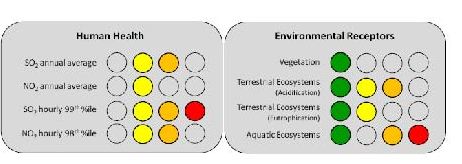Also discussed here: New airshed study is a “nail in the coffin” for government LNG dreams in Kitimat(Andrew Weaver, Jul. 18, 2014)
Today we review an environmental impact assessment report prepared for the British Columbian government in anticipation of developments associated with Liquid Natural Gas Terminals that could affect human health and the environment. The developments include an existing aluminum smelter, four proposed LNG terminals, a proposed oil refinery, and gas turbine powered electrical generation facilities, as well as related marine transportation sources. The assessment used a colour-coded system for impacts of air pollution on human health ranging from green for “clean environment” though yellow and orange to red for values that breach the US EPA National Ambient Air Quality Standards. Similarly for natural environmental impacts on vegetation, lakes and soil they range from green for negligible impact through to red where the impact is considered to be “extremely unacceptable”.
The results indicate a red for human health for hourly SO2 and a red for aquatic ecosystems. In the words of Dr. Andrew Weaver, the only member of the provincial parliament with an advanced degree in environmental science, in addition to be a world leader in climate science and modeling “The study undeniably concludes that if you put four LNG plants into Kitimat you will have critical impacts on human health.”. Nothing more needs to be said …. except STOP.

Key Quotes:
“Kitimat’s location at the head of Douglas Channel in northwestern British Columbia (BC) makes it an attractive location for industries seeking a marine terminal along BC’s Pacific Coast in order to access foreign markets. Numerous liquefied natural gas (LNG) facilities as well as an oil refinery and a crude oil export terminal have been proposed for the Kitimat area, which is placing new and urgent demands upon regulatory decision-making processes.”
“The industrial facilities explored in the assessment included an existing aluminum smelter, four proposed LNG terminals, a proposed oil refinery, and gas turbine powered electrical generation facilities, as well as related marine transportation sources.”
“Annual SO2 and NO2 averages: In the Service Centre, the values span the Yellow and Orange category.”
“Hourly SO2 averages: The three Near locations had SO2 maximum 99th percentile values within the Red category for Scenarios A_28.2 through Is/Im_83.3,”
“Hourly NO2 averages: Two different background levels were compared. Using the Quesnel background level, the three Near locations had maximum 98th percentile values categorized as Orange”
“The study undeniably concludes that if you put four LNG plants into Kitimat you will have critical impacts on human health.”
“even under the best case scenario with no oil refinery and with full treatment of Rio Tinto Alcan smelter emissions, four new LNG plants will raise sulphur dioxide levels to the point of causing “critical” risk to human health. Those plants will also increase nitrogen dioxide levels to the point of causing “high” risk to human health.”









No comments:
Post a Comment